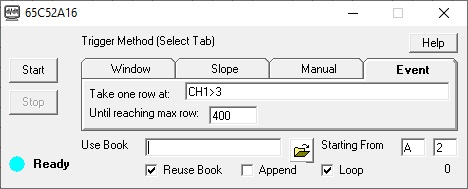Why Do We Need Trigger Modes
Analog trigger modes have been around ever since oscilloscopes were introduced. Besides letting you stabilize repeating waveforms in an oscilloscope-like display, analog trigger mode in data acquisition is especially important to capture data of interest, instead of trying to locate the data of interest from mega and mega samples, like trying to find the needle in the haystack
Traditional Analog Trigger Modes in Data Logging
- Window trigger allows user to capture data when signal is inside or outside a certain range, e.g. when temperature is outside the range of 34C and 42C
- Slope trigger allows user to capture the data when signal pass a trigger point on rising or falling edge, e.g. when Voltage goes from 1V to 2V, passing a trigger point of 1.8V
- Calculated trigger allows user to use the math result of multiple channels to set up a more advanced trigger point, e.g. Voltage*Current=Power
- Delayed trigger allows user to capture data with a delay from a trigger condition, e.g. the data of interest is 3 seconds after the reading passes 4V
Problem with Traditional Trigger Mode
- One major problem with traditional analog trigger modes is it can't trigger on glitch, or rate of change. To demonstrate the problem, look at the following waveform, we need to trigger on the glitch in red circle. Since it is has the same signal strenght as the rest of the waveform, none of the traditional analog trigger modes can capture it.

Derivative Trigger is the Solution
- The most effective way to capture such glitch is to apply the first-order derivative to the analog signal, below is the result of the such derivative from AdvanaceCODAS package

- Now the abnormalty stands out, and we can trigger on it easily. Although the first order of derivation is described as df/dt, in practice of data acquisition, since dt, which is the inverse of sample rate, is always the same during the session, we can simply substitute df/dt with df and monitor the change of df continuously. As the result, we can use CH1-CH[T-1]1>3 in WinDaq ExcelLink to capture this glitch easily.
WinDaq ExcelLink in Action
- We look at a wavform swinging across the full range, we need to capture a glitch in the chart above, by using trigger condition (CH1-CH[T-1]1)>5, pre trigger 200 and post trigger 160, ExcelLink will wait until the reading of first channel has a sudden positive jump greate than 5, before sending 200 rows of data before the trigger point and 160 rows of data after the trigger point to Excel.


Application
- A customer conducting long-term bearing testing for motors needs to capture data around the time when the bearing fails. When the bearing is performing well, the sensor connected to the shaft generates a smooth and lower frequency waveform. When the bearing begins to fail, it causes vibration, thus adding glitches to the waveform (See image below for reference). With Derivative Trigger, the failure can be captured easily.

Video


 View Cart
View Cart sales@dataq.com
sales@dataq.com 330-668-1444
330-668-1444

